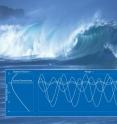Man-made carbon dioxide affects ocean acoustics
There is little doubt among scientists now that human carbon dioxide emissions are warming the planet. Another problem of rising atmospheric carbon dioxide (CO2) is that CO2 is being absorbed by the oceans, which increases seawater acidity (lowers the seawater pH). This process, termed 'ocean acidification', has received growing scientific and public interest because it threatens certain groups of marine organisms, including corals. Only recently have researchers realized that man-made carbon dioxide not only warms and acidifies the ocean – it also affects acoustical properties of seawater, making it more transparent to low-frequency sound. Oceanographers Tatiana Ilyina and Richard Zeebe of the School of Ocean and Earth Science and Technology at the University of Hawaii at Manoa, together with Peter Brewer of the Monterey Bay Aquarium Research Institute write in the journal Nature Geoscience that seawater sound absorption will drop by up to 70% already during this century. The scientists have examined the effects of man-made carbon dioxide under business-as-usual emissions and provide projections of the magnitude, time scale, and regional extent of changes in underwater acoustics resulting from ocean acidification.
When carbon dioxide dissolves in seawater, it produces carbonic acid and increases the hydrogen ion concentration (acidity). The seawater pH has declined by about 0.1 units compared to preindustrial levels – corresponding to about 25% increase in acidity. These changes may appear small, but pH is measured on a logarithmic scale – analogous to the Richter scale, which measures the strength of Earthquakes. For example, a drop of pH by one unit implies a ten-fold increase in acidity. Low-frequency sound absorption depends on the concentration of dissolved chemicals such as boric acid, which in turn, depends on seawater pH. This is the reason why changes in seawater pH affect ocean acoustics.
"If we continue to emit carbon dioxide at business-as-usual rates, the pH of surface seawater will drop by 0.6 units by the year 2100. As a result, the absorption of 200 Hz sound would decrease by up to 70%", says Tatiana Ilyina. For example, the middle C of the piano is tuned to 261.6 Hz; in the ocean, sound around this frequency is produced by natural phenomena such as rain, wind, and waves (see Figure), by marine mammals, and by man-made activities such as construction, shipping, and use of sonar systems.
"Most people know that when they turn on the air conditioner or drive a vehicle, they emit carbon dioxide, which causes climate change and ocean acidification. The surprise now is that it also affects sound absorption in the ocean", says Zeebe. "What is happening over time is that the low frequencies become louder at distance. It's similar to the effect when you slowly turn up the bass on your stereo."
However, underwater sound propagation is much more complex; it depends on spatial distribution of sound sources and environmental parameters. Some areas in the ocean will be affected more strongly than others. Areas with large sound absorption reduction and intense noise sources, for example from shipping, could become "acoustic hot spots" in the future. The largest changes are projected to occur in the surface ocean waters in high latitudes, for instance, in the North Pacific and in the Southern Ocean, and in the areas of deep water formation such as the North Atlantic, where man-made CO2 invasion is the greatest.
Sound can travel farther at depth of about 1000 m (the depth of the so called deep sound channel) than at the surface. Most of the anthropogenic and natural sounds are generated at the surface, but they can leak into the deep sound channel, bend there, and travel over thousands of kilometers in the ocean (see Figure). "With time, as anthropogenic CO2 penetrates into the deep ocean, the changes in sound absorption will also propagate well below the deep sound channel axis", says Ilyina. "Sound absorption will continue to decrease even after reductions in CO2 emissions because ocean pH will continue to decrease."
Human activities such as naval, commercial, and scientific applications extensively use low-frequency sound due to its long-range propagation. Also marine mammals rely on low-frequency sound to find food and mates. As a result, ocean acidification may not only affect organisms at the bottom of the food chain by reducing calcification in plankton and corals, but also higher trophic level species, such as marine mammals by lowering sound absorption in the ocean.
"We don't fully understand what the impacts of these changes in ocean acoustics will be", says Ilyina. "Because of decreasing sound absorption, underwater sound could travel farther, and this could lead to growing noise levels in the oceans. Increasing transparency of the oceans to low-frequency sounds could also enable marine mammals to communicate over longer distances." The scientists say that further research is needed to address these questions.
Source: University of Hawaii at Manoa
Other sources
- Man-made carbon dioxide affects ocean acousticsfrom Science DailyWed, 23 Dec 2009, 1:14:37 UTC
